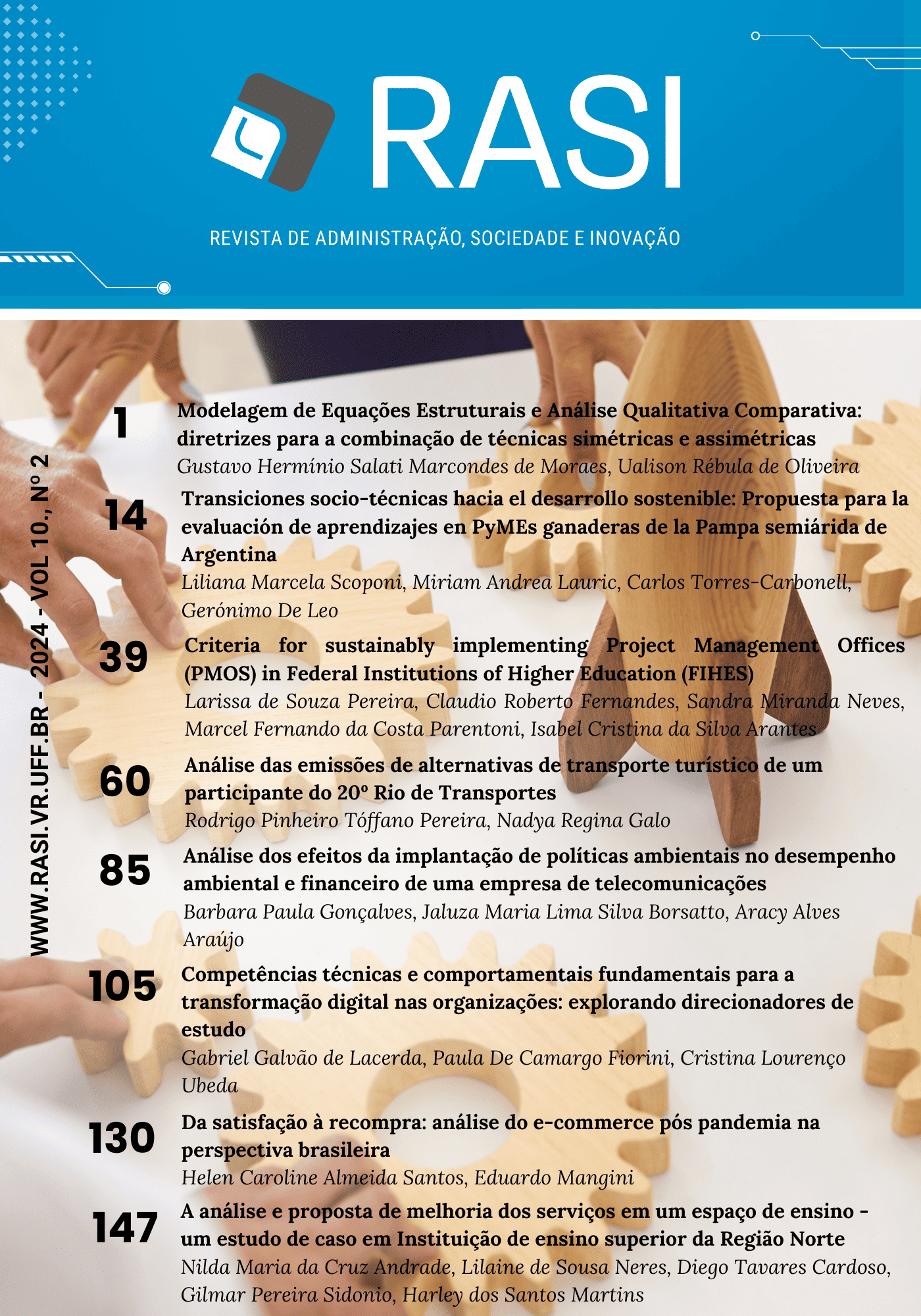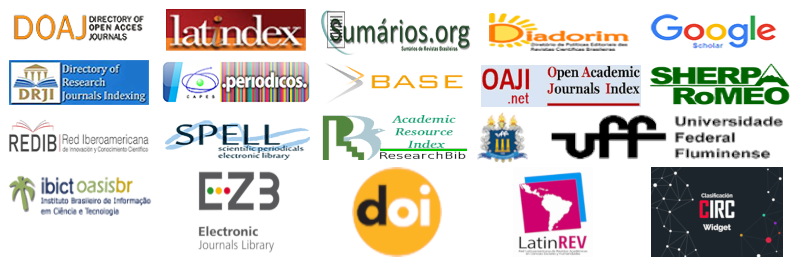Modelagem de Equações Estruturais e Análise Qualitativa Comparativa: diretrizes para a combinação de técnicas simétricas e assimétricas
DOI:
https://doi.org/10.20401/rasi.10.2.931Keywords:
Modelagem de Equações Estruturais, Análise Qualitativa ComparativaAbstract
Editorial
Downloads
References
Andrés-Sánchez, J., & Puchades, L. G. V. (2023). Combining fsQCA and PLS-SEM to assess policyholders’ attitude towards life settlements. European Research on Management and Business Economics, 29(2), 100220. https://doi.org/10.1016/j.iedeen.2023.100220
Cepeda-Carrion, G., Cegarra-Navarro, J. G., & Cillo, V. (2019). Tips to use partial least squares structural equation modelling (PLS-SEM) in knowledge management. Journal of Knowledge Management, 23(1), 67–89. https://doi.org/10.1108/JKM-05-2018-0322
Cifci, I., Kahraman, O. C., Tiwari, S., & Rasoolimanesh, S. M. (2023). Demystifying meal-sharing experiences through a combination of PLS-SEM and fsQCA. Journal of Hospitality Marketing & Management, 32(7), 843–869. https://doi.org/10.1080/19368623.2023.2215222
Cole, D. A., & Preacher, K. J. (2014). Manifest variable path analysis: Potentially serious and misleading consequences due to uncorrected measurement error. Psychological Methods, 19(2), 300–315. https://doi.org/10.1037/a0033805
Das, S., & Datta, B. (2024). Application of UTAUT2 on Adopting Artificial Intelligence Powered Lead Management System (AI-LMS) in passenger car sales. Technological Forecasting and Social Change, 201, 123241. https://doi.org/10.1016/j.techfore.2024.123241
Do Prado, N. B., Moraes, G., Fischer, B. B., Anholon, R., & Rampasso, I. S. (2022). Antecedents of environmental value creation: an analysis with ecopreneurs in a developing country. International journal of sustainable development and world ecology, 29(8), 709–724. https://doi.org/10.1080/13504509.2022.2080296
Durdyev, S., Ismail, S., Ihtiyar, A., Abu Bakar, N. F. S., & Darko, A. (2018). A partial least squares structural equation modeling (PLS-SEM) of barriers to sustainable construction in Malaysia. Journal of Cleaner Production, 204, 564–572. https://doi.org/10.1016/j.jclepro.2018.08.304
Fauzi, M. A. (2022). Partial least square structural equation modelling (PLS-SEM) in knowledge management studies: Knowledge sharing in virtual communities. Knowledge Management & E-Learning: An International Journal, 103–124. https://doi.org/10.34105/j.kmel.2022.14.007
Fiss, P. C. (2011). Building better causal theories: a fuzzy set approach to typologies in organization research. Academy of Management Journal, 54(2), 393–420.
Guenther, P., Guenther, M., Ringle, C. M., Zaefarian, G., & Cartwright, S. (2023). Improving PLS-SEM use for business marketing research. Industrial Marketing Management, 111, 127–142. https://doi.org/10.1016/j.indmarman.2023.03.010
Hair, J. F., Hult, G. T. M., Ringle, C. M., Sarstedt, M., & Thiele, K. O. (2017). Mirror, mirror on the wall: a comparative evaluation of composite-based structural equation modeling methods. Journal of the Academy of Marketing Science, 45(5), 616–632. https://doi.org/10.1007/s11747-017-0517-x
Hair, J. F., Sarstedt, M., Ringle, C. M., & Gudergan, S. P. (2024). Advanced Issues in Partial Least Squares Structural Equation Modeling (PLS-SEM) (2e) (Thousand Oaks). Sage.
Huang, Y., Li, P., Bu, Y., & Zhao, G. (2023). What entrepreneurial ecosystem elements promote sustainable entrepreneurship? Journal of Cleaner Production, 422, 138459. https://doi.org/10.1016/j.jclepro.2023.138459
Kaya, B., Abubakar, A. M., Behravesh, E., Yildiz, H., & Mert, I. S. (2020). Antecedents of innovative performance: Findings from PLS-SEM and fuzzy sets (fsQCA). Journal of Business Research, 114, 278–289. https://doi.org/10.1016/j.jbusres.2020.04.016
Lee, J. H., Joo, D., Lee, C.-K., Parkt, Y. N., & Kwon, Y.-J. (2022). The role of residents’ sustainable intelligence in agricultural heritage site management: Insights from PLS-SEM and Fs/QCA. Journal of Hospitality and Tourism Management, 52, 65–74. https://doi.org/10.1016/j.jhtm.2022.06.004
Magno, F., Cassia, F., & Ringle, C. M. (2022). A brief review of partial least squares structural equation modeling (PLS-SEM) use in quality management studies. The TQM Journal. https://doi.org/10.1108/TQM-06-2022-0197
Moraes, G. H. S. M., Fischer, B., Salles-Filho, S., Meissner, D., & Dabic, M. (2023). More than one way to get there: a configurational view on performance drivers in knowledge-intensive entrepreneurship. Journal of Knowledge Management, 27(11), 205–230. https://doi.org/10.1108/JKM-03-2023-0267
Moraes, G. H. S. M., Pelegrini, G. C., Marchi, L. P., Pinheiro, G. T., & Cappellozza, A. (2022). Antecedents of big data analytics adoption: an analysis with future managers in a developing country. The Bottom Line, 35(2/3), 73–89. https://doi.org/10.1108/BL-06-2021-0068
Olya, H. G. T. (2023). Towards advancing theory and methods on tourism development from residents’ perspectives: Developing a framework on the pathway to impact. Journal of Sustainable Tourism, 31(2), 329–349. https://doi.org/10.1080/09669582.2020.1843046
Pappas, I. O., & Woodside, A. G. (2021). Fuzzy-set Qualitative Comparative Analysis (fsQCA): Guidelines for research practice in Information Systems and marketing. International Journal of Information Management, 58, 102310. https://doi.org/10.1016/j.ijinfomgt.2021.102310
Pelegrini, G. C., & Moraes, G. H. S. M. (2021). Does gender matter? A university ecosystem, self-efficacy and entrepreneurial intention analysis in Brazilian universities. Gender in Management. https://doi.org/10.1108/GM-01-2021-0007
Ragin, C. C. (2008). Redesigning Social Inquiry: Set Relations in Social Research. University of Chicago Press.
Rasoolimanesh, S. M., Ringle, C. M., Sarstedt, M., & Olya, H. (2021). The combined use of symmetric and asymmetric approaches: partial least squares-structural equation modeling and fuzzy-set qualitative comparative analysis. International Journal of Contemporary Hospitality Management, 33(5), 1571–1592. https://doi.org/10.1108/IJCHM-10-2020-1164
Richter, N. F., Schubring, S., Hauff, S., Ringle, C. M., & Sarstedt, M. (2020). When predictors of outcomes are necessary: guidelines for the combined use of PLS-SEM and NCA. Industrial Management & Data Systems, 120(12), 2243–2267. https://doi.org/10.1108/IMDS-11-2019-0638
Rihoux, B., & Ragin, C. (2009). Configurational Comparative Methods: Qualitative Comparative Analysis (QCA) and Related Techniques. SAGE Publications, Inc. https://doi.org/10.4135/9781452226569
Santana, R. S., Moraes, G. H. S. M. de, & Silva, H. M. R. da. (2021). Relational attractiveness between supplier-customer in a supply chain. RAUSP Management Journal, 56(1), 109–128. https://doi.org/10.1108/RAUSP-09-2019-0202
Sukhov, A., Friman, M., & Olsson, L. E. (2023). Unlocking potential: An integrated approach using PLS-SEM, NCA, and fsQCA for informed decision making. Journal of Retailing and Consumer Services, 74, 103424. https://doi.org/10.1016/j.jretconser.2023.103424
Väätäinen, M., & Dickenson, P. (2019). (Re)examining the effects of athlete brand image (ABI) on psychological commitment: an empirical investigation using structural equation modelling (SEM) and fuzzy set qualitative comparative analysis (fsQCA). European Sport Management Quarterly, 19(2), 244–264. https://doi.org/10.1080/16184742.2018.1508242
Woodside, A. G. (2013). Moving beyond multiple regression analysis to algorithms: Calling for adoption of a paradigm shift from symmetric to asymmetric thinking in data analysis and crafting theory. Journal of Business Research, 66(4), 463–472. https://doi.org/10.1016/j.jbusres.2012.12.021
Yesuf, Y. M., Getahun, D. A., & Debas, A. T. (2024). Determinants of employees’ creativity: modeling the mediating role of organizational motivation to innovate. Journal of Innovation and Entrepreneurship, 13(1), 8. https://doi.org/10.1186/s13731-024-00364-w
Yuan, K. H., Wen, Y., & Tang, J. (2020). Regression Analysis with Latent Variables by Partial Least Squares and Four Other Composite Scores: Consistency, Bias and Correction. Structural Equation Modeling: A Multidisciplinary Journal, 27(3), 333–350. https://doi.org/10.1080/10705511.2019.1647107
Zhang, H., & Zhang, Y. (2019). Comparing fsQCA with PLS-SEM: predicting intended car use by national park tourists. Tourism Geographies, 21(4), 706–730. https://doi.org/10.1080/14616688.2018.1540652
Zhao, J., & Yan, C. (2020). User Acceptance of Information Feed Advertising: A Hybrid Method Based on SEM and QCA. Future Internet, 12(12), 209. https://doi.org/10.3390/fi12120209
Downloads
Published
Issue
Section
License
Copyright (c) 2024 Review of Administration, Society and Innovation

This work is licensed under a Creative Commons Attribution 4.0 International License.
RASI, in accordance with Law No. 9,610 of February 19, 1998, which amends, updates and consolidates Brazilian copyright law and makes other provisions, adopts the following conditions of the Copyright Assignment:
1. RASI maintains, with the transfer of copyrights, the possession of rights over the content published;
2. The author retains his moral rights of the content, including the right to be identified as the author whenever the content is published;
3. Despite the attribution of copyright, the author retains the right to reuse the material in future collections of his own work without encumbrance. The acknowledgments of the previous publication in the RASI are the only requirements in such cases;
4. The author may make photocopies of the content, or distribute it by electronic mail or fax, provided that they are intended for their own classes and for the purpose of meeting research objectives, provided that: (a) such copies are not resold and (b) reference to the original source of the publication and the name of the RASI are clearly indicated on all copies made of the document.











